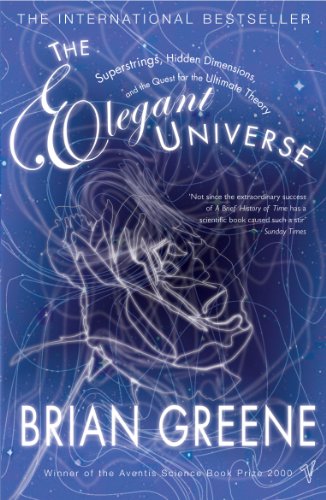It's been a while...

A while indeed! If there’s been any interval in my life when life had changed the most, it should be within my last blog post and this one. But those will be separate post altogether.
This post isn’t the review of the book. It’s just an account of relevant experience that I went through while reading the book and a rough summary. The book tries to educate about a theory (M-theory) on physics which states that the universe at the tiniest scale is composed of vibrating ‘strings’ or their higher dimensional counterparts (branes). It starts by playing around with space and time and how the smoothness of space and time as depicted in ‘General Relativity’ doesn’t fit in with the laws of ‘Quantum Mechanics’ while observing the quantum properties of field / matter when probed on a tiny scale. The books suggests that the universe could be composed of other spatial dimensions that might be so tightly curled that those cannot be experienced ordinarily. The book further suggests that the vibrations of ‘branes’ could be happenning in the extended dimensions in such a way that it cancels out the weird incompatibilty between quantum mechanics and general relativity. The theory claims that if proven true and if solved properly, the theory should be able to “predict” the fundamental constants of nature as well as give reasons as to why we have 3 spatial dimensions and 1 time dimension and if nature had / has any alternative choice(s).
To be honest, I didn’t learn anything super technical from the book at all, which is fair given that the goal of the book probably was not to give a theoretical explanation. It didn’t add much “information” about the universe itself but I had some fun time stretching my mind to its limits imagining higher dimensions, shapes in higher dimensions and their possible configurations and meaning. Apart from the technical stuff, it did succeed to stir a sense of motivation to get back to physics, which was the reason why I had undertaken reading this book at first place. One noteworthy thing about the book, specially on the later sections is that the author refers to so many other works which gave a feeling of studing research articles, but also signified that as we go into more and more depth, we inevitably use abstraction to include details of previous works to account for the whole picture. Overall, the book reading experience was not a great one.
While reading the book, I got an affirmation that reading books itself is an art, and not everyone appreciate art equally. A great reader is full of patience and meditative focus on the subject matter and to me a good-read is as close to meditation as it can get. I only ocassionally had such good sessions but my unrest also sources from the fact that the book was too repetitive at times and didn’t bring anything really new to my plate. I strongly felt at times that I would and should rather spend time solving small problems than reading “big theories” that would not amount to anything substantial as far as mathematical rigor is concerned. I also felt that reading pure literature or doing other form of art is better option than spending time on books that talk about phyisics but don’t do physics. Obviously, all of this applies to me because of my personal background and inclination.
Dr. Brian Greene, a handsome theoretical physicist, a string theorist, who brought string theory to a large audience through his books and other forms of communication stands among one of the greatest scientist of this era. He is an inspiration for many.
Last Updated: Wednesday, Jun 14, 2023, 04:01 AEST(UTC+10) Author: Madhav Om (scimad)